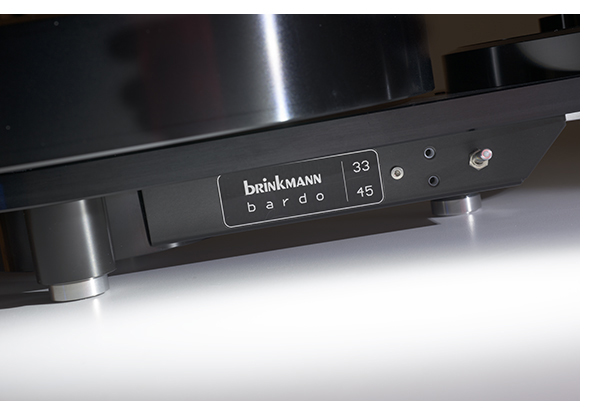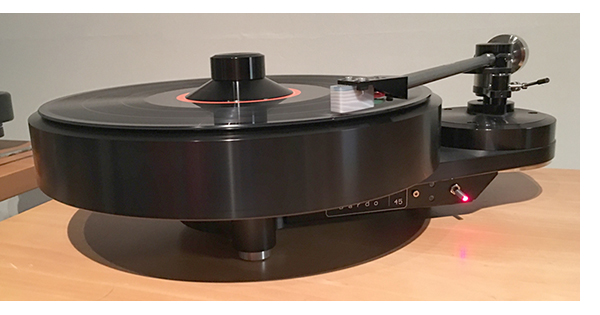The Brinkmann Audio Bardo Turntable TONEAudio's Analog Product of the Year for 2016!
By Jeff Dorgay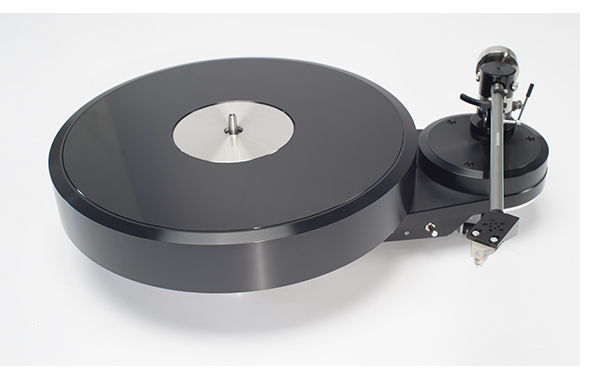 Closing the door on a Porsche 911, clicking the shutter on a titanium bodied Leica camera, that’s German engineering excellence, baby!
Closing the door on a Porsche 911, clicking the shutter on a titanium bodied Leica camera, that’s German engineering excellence, baby!
If you love that level of precision to go along with whatever high-performance product that suits your fancy, you’ll freak out just watching the 10.0 tonearm on the new Bardo lower ever so gently onto a waiting LP. This is such a precise, delicate action, the stylus cantilever on the Koetsu Onyx Platinum barely deflects at all. Those of you wanting to install a mega cartridge on your Bardo can rest assured it is up to the task.
As Adrian Belew’s trippy, reverse tracked, overdubbed vocals in “Big Electric Cat” go all the way from the edges of my speakers, out about seven more feet to the walls of my listening room, with detail galore, it’s easy to fall in love with this table. The Koetsu Onyx Platinum cartridge that costs as much as the Bardo puts forth a more engaging performance than it has here in any of my other reference turntables. Here, here for synergy. During the review period, everything from a Shure M97 to the Koetsu has been taken for a test drive, but the Japanese masterpiece wins the day. Everything on hand works exceptionally well with the Bardo. However, this table is fully up to the task of a $10k premium cartridge. It’s that good.
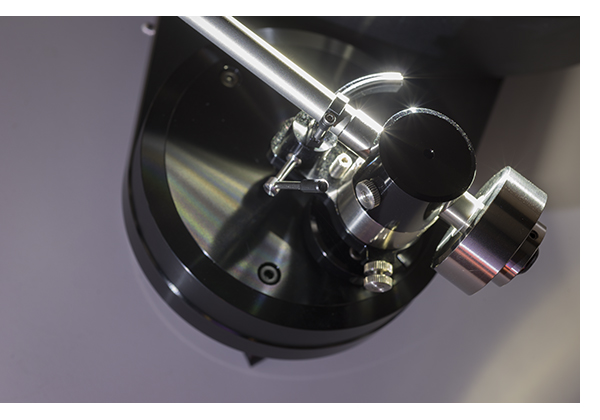 Living with Brinkmann’s direct drive Bardo for the last few months has been nothing but joy. This table is incredibly easy to set up, stays set up and is equally easy to use. With direct drive coming back in vogue these days, there are a few other DD tables on the market, but they are both considerably more expensive than the Bardo. Thanks to a change in their distribution scheme, and a Brinkmann USA office in place, the German manufacturer is now able to be much more price competitive, and that’s a great thing for analog lovers. The Bardo table/10.0 arm was still a fantastic deal at $13,500, but at $9,900, this is a straight out bargain for those wanting a world class, destination analog deck.
Living with Brinkmann’s direct drive Bardo for the last few months has been nothing but joy. This table is incredibly easy to set up, stays set up and is equally easy to use. With direct drive coming back in vogue these days, there are a few other DD tables on the market, but they are both considerably more expensive than the Bardo. Thanks to a change in their distribution scheme, and a Brinkmann USA office in place, the German manufacturer is now able to be much more price competitive, and that’s a great thing for analog lovers. The Bardo table/10.0 arm was still a fantastic deal at $13,500, but at $9,900, this is a straight out bargain for those wanting a world class, destination analog deck.
Should you want the benefits of Brinkmann’s direct drive expertise, but already have your favorite tonearm on hand, Brinkmann can supply whatever arm board you need. Ordering a Bardo sans tonearm will only set you back $7,000. Considering what a great job they do with their tonearm, which Helmut Brinkmann refers to as a hybrid unipivot design (and you can read more here http://www.brinkmann-audio.com/main.php?prod=tonarm100&lang=en) both mechanically and visually, it seems pointless to use another arm. But you can if you want to. To clarify the “hybrid” moniker, Helmut Brinkmann tells us that “his proprietary design uses Swiss-made gimbal bearings in the vertical plane and a bespoke unipivot in the horizontal.”
Multiple connectivity options make this beautiful table even easier to integrate into your system. Our review sample arrives with standard RCA connections going from table to phono preamplifier, but you can also opt for balanced XLR connections (this will take a little longer for delivery, as the RCA’s are standard issue), or a 5-pin DIN socket. Modifying an existing Brinkmann arm to a Din connector will set you back an additional $180. Handy if you already have a premium tonearm cable in your arsenal.
A further performance upgrade is available with the optional RoNt vacuum tube power supply ($4,190) for those wanting still more performance. A few Brinkmann owners have commented that this is not a subtle improvement, so look forward to a follow-up review sometime next year.
The easier a turntable is to use, the more likely it is to get used. The Bardo takes up a small footprint and being a non-suspended table, you may want to install one of the better isolation bases, like the ones from SRA; it all depends on your room and taste. My floor is relatively inert and thanks to an SRA Scuttle rack, I felt no need to improve on the Bardo’s placement in my room.
Going way back to the obscure bin, an old favorite, Tim Curry’s Fearless is an album full of slick late 70s production, with some of rock’s favorite sidemen backing up Dr. Frank-n-Furter in his alternate career as a serious musician. The bass line in this record has always sounded somewhat vague, yet when portrayed by the Bardo, it’s rock solid. Actually, everything played on the Bardo has an uncanny sense of pace to it. The nearly $40k AVID Acutus REF SP and SME V has a little more weight in the lows and delicacy in the highs, but the Bardo is unbeatable at its price point.
Direct drive is not a dirty phrase
It goes without saying that a lot of the resolution the Bardo offers comes from meticulous build quality and attention to detail. Much of the major pace and timing accuracy this table delivers comes from the direct drive system. Utilizing Feickert’s iPhone app to check speed accuracy reveals most belt drive turntables to be relatively close to spinning at 33.33 r.p.m., but there is a fair amount of variation on the theme.
Watching the real-time speed graph for the Bardo, it’s near flat across the board. The phrase “rock solid” definitely applies here. Because Brinkmann implements direct drive the opposite way that the legendary Technics tables did, the result is much more to the liking of a modern audiophile.
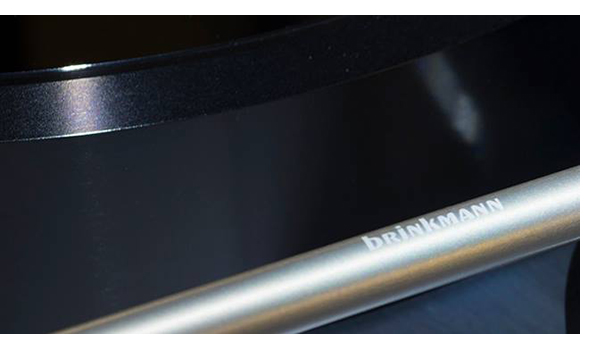 Technics DD tables, initially designed for the broadcast world, used a high torque motor, hammered into speed accuracy by a quartz lock control mechanism, resulting a lot of motor “cogging.” This is what happens in the small spaces in the 360-degree rotation of the motor that don’t always have power applied. Unfortunately, this aggressive speed control did exactly the opposite of what was intended. Pulling out my SL-1200, with the excellent TimeStep power supply and a stock SL-1200, tracks played on the Brinkmann get progressively flatter in terms of three dimensionality, going back to the TimeStep equipped 1200 and then a stock one. It’s easy to see how the early direct drive tables got pooh-poohed, and I can see how easy it was to be seduced by the Oracle back in the early 80s.
Technics DD tables, initially designed for the broadcast world, used a high torque motor, hammered into speed accuracy by a quartz lock control mechanism, resulting a lot of motor “cogging.” This is what happens in the small spaces in the 360-degree rotation of the motor that don’t always have power applied. Unfortunately, this aggressive speed control did exactly the opposite of what was intended. Pulling out my SL-1200, with the excellent TimeStep power supply and a stock SL-1200, tracks played on the Brinkmann get progressively flatter in terms of three dimensionality, going back to the TimeStep equipped 1200 and then a stock one. It’s easy to see how the early direct drive tables got pooh-poohed, and I can see how easy it was to be seduced by the Oracle back in the early 80s.
Mr. Brinkman’s low torque approach, coupled to a heavy platter and world class bearing makes for smooth sailing. It takes about 8-10 rotations to get up to full speed, which is about the amount of time that it takes for the tonearm to set, and once you shut the power off, it rotates for a long time before coming to full stop. Brinkmann’s research led him to the current lead crystal platter insert in the aluminum platter, making for a major increase in resolution over one strictly machined from aluminum. Brinkmann spends a tremendous amount of time on materials research alone, and on his website, he claims this goes all the way down to the fasteners used to hold things together! The proof is in the listening; this is a very refined design.
Controlled ease
The presentation of the Bardo is indeed unique. Record after record has an ease and freedom from fatigue, again because of the excellent speed accuracy this table offers. Friends with canine hearing claiming perfect pitch that can hear a plethora of speed issues on every table I’ve ever reviewed were not only dead silent listening to the Bardo but they were also outright complimentary. Violins take on a magical realism with this table because of that speed accuracy.
You’ll probably key in immediately to how great your rock records sound, should you be a fan of this genre. The Bardo does a great job in the bass performance, but if you live on a strict diet of Zeppelin, you might not notice the subtleties of this table quite as much as the classical listener preferring soloists and small ensemble music. Sampling this fair gives the Bardo a near reel to reel tape like transparency.
Our choice for Analog POY
Here’s why the Brinkmann Bardo is our choice for 2016 Analog Product of the Year; it offers tremendous value, build quality, sound quality and ease of use. I’ve listened to my fair share of $100,000 plus turntables and have always walked away unimpressed. You can buy a pretty major hi-fi system for $100k, and I suggest if you take that path, you put the Bardo on top of your rack. Seriously, other than a few audio reviewers and a couple of hedge fund managers that got a screaming deal, who owns a $100,000 turntable anyway?
Wacky as it might sound, the $10,000 – $20,000 category is the hottest category for “destination” turntables. There are a handful of great tables costing 2-3 times this much (like the SME 30, the AVID Acutus REF SP and a few others), and they do reveal more music for sure. But again, the Brinkmann Bardo presents so much music, especially with your choice of awesome $5,000 – $10,000 cartridge, I’ll stick my neck out and say that most of us could live happily ever after right here.
If you’re currently using a table in the $3,000 – $5,000 category, you will be floored at just how much more musical information and nuance that the Bardo can shed light on, that if you have the purchasing power, this won’t be a difficult decision.
I’ve purchased the review sample and plan on spinning a lot more records on the Bardo. It’s simple, elegant, yet high-performance design has captured my enthusiasm. Should you be planning on buying a table in this price range, I not only recommend the Bardo, I sincerely hope you will audition one, and see if you enjoy it as much as I do.
MSRP: $9,900 with Brinkmann 10.1 tonearm ($260 savings, purchasing the bundle)
Peripherals
Phono Cartridge Koetsu Onyx Platinum, Ortofon Cadenza Black
Phonostage Pass XS Phono
Preamp Pass XS Pre
Power Amps Pass XS 300 monoblocks
Speakers GamuT RS5i, MartinLogan Neolith, Quad 2812
Cable Tellurium Q Black Diamond speaker and interconnect,
Power cords Cardas Clear



